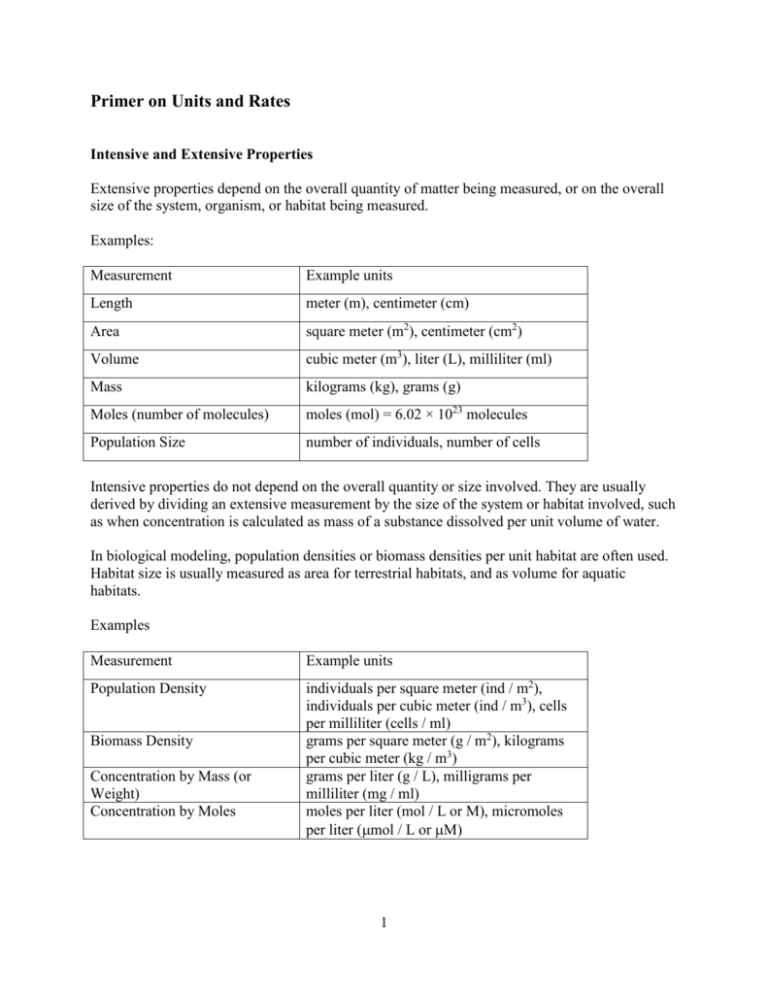Primer on Units and Rates
advertisement

Primer on Units and Rates Intensive and Extensive Properties Extensive properties depend on the overall quantity of matter being measured, or on the overall size of the system, organism, or habitat being measured. Examples: Measurement Example units Length meter (m), centimeter (cm) Area square meter (m2), centimeter (cm2) Volume cubic meter (m3), liter (L), milliliter (ml) Mass kilograms (kg), grams (g) Moles (number of molecules) moles (mol) = 6.02 × 1023 molecules Population Size number of individuals, number of cells Intensive properties do not depend on the overall quantity or size involved. They are usually derived by dividing an extensive measurement by the size of the system or habitat involved, such as when concentration is calculated as mass of a substance dissolved per unit volume of water. In biological modeling, population densities or biomass densities per unit habitat are often used. Habitat size is usually measured as area for terrestrial habitats, and as volume for aquatic habitats. Examples Measurement Example units Population Density individuals per square meter (ind / m2), individuals per cubic meter (ind / m3), cells per milliliter (cells / ml) grams per square meter (g / m2), kilograms per cubic meter (kg / m3) grams per liter (g / L), milligrams per milliliter (mg / ml) moles per liter (mol / L or M), micromoles per liter (mol / L or M) Biomass Density Concentration by Mass (or Weight) Concentration by Moles 1 Algebra with Units Most scientific quantities have units of measurement attached to them. These units should be included when doing calculations with such quantities (though this is not always done explicitly in literature to be read by experienced scientists and mathematicians). Units of measurement can be treated as algebraic symbols, and calculations involving units of measurement follow the normal rules of algebra. Examples: According to physics, the momentum of a moving object is its mass times its velocity, and its kinetic energy is ½ its mass times its velocity squared. What is the momentum and kinetic energy of a 0.3 kg bird flying at 9 m/s? momentum 0.3kg 9 m kg m 2.7 s s 1 kg m 2 m kinetic energy 0.3kg 92 12.15 2 s2 s 2 A reach of a stream is 100 m long with a cross-sectional area of 0.25 m2. What is its volume? volume 100 m 0.25m2 25m3 The population density of dragonfly larvae in the stream is 3.2 ind / m3. What is the population size of dragonfly larvae in the stream? population size habitat size × population density 25 m3 3.2 ind 80 ind m3 An ecologist studying a grassland removes all plants from a circle of radius 0.05 m, and determines that their biomass is 8 g. What is the biomass density of the plants? biomass density biomass 8g g 1019 2 2 2 area 0.05 m m Unit Conversions A conversion factor is a ratio of a quantity measured in one unit to the quantity measured in a different unit. Useful references for conversion factors are the Handbook of Chemistry and Physics, and many web sites that appear when you google “conversion factor”. The algebra of ratios and fractions is used when making conversions. 2 Examples: A reach of a stream is 100 m long. What is its length in feet? 100 m 3.2808 ft 328.08 ft m A beaker contains 1.5 L of nutrient medium. What is the volume of medium in quarts? 1.5 L 1.0567 qt 1.585 qt L To deal with areas and volumes, conversion factors for can be raised to powers. Examples: A forest is 100 km2. What is its area in square miles? 2 0.62187 2 mi 2 0.621872 mi 2 0.38672 mi2 0.62187 mi 100 km km km 2 km 2 km 2 2 = 38.67 mi2 A reach of stream has a volume of 25 m3. What is its volume in cubic feet? 3 3 3 35.3134 ft 3 3.2808 ft 3.2808 ft 25 m3 882.8 ft3 3 3 m m m Various conversion factors and powers can be combined as needed for various calculations. Examples A reach of stream has a volume of 25 m3. What is its volume in gallons? 25 m3 264.17 gal 22070 gal m3 The biomass of density plants in a grassland is 1019 g / m2. What is the biomass density in tons per square mile? 1609 m 0.002205 lb ton 2 1019 g / m 2908 tons / mi mi g 2000 lb 2 2 3 Moles, masses, and chemical concentrations It is very helpful for those doing biological sciences to be able to do basic chemical calculations that work with both molar concentrations and mass (or weight) concentrations. A mole is an amount of a substance containing 6.02 × 1023 molecules. Since the molecules of different substances have different masses, a mole of one substance does not have the same mass as a mole of a different substance. Likewise, a gram of one substance contains a different number of molecules from a gram of another substance. Useful conversions between measurements in moles and measurements as mass are based on the “gram-molecular weight” or “formula weight” of the substance in question. The gram-molecular weight of a substance is its molecular weight expressed in grams. The molecular weight is the sum of the atomic weights of the elements in its molecular formula. Atomic weights can be obtained from periodic tables of the elements, which are printed in nearly every chemistry textbook and widely available on the web. Examples: Water, H2O, gram-molecular weight = 2×1 + 16 = 18 Glucose, C6H12O6, gram-molecular weight = 6 × 12 + 12 × 1 + 6 × 16 = 180 For any substance, the conversion factor between moles and mass is its gram-molecular weight per one mole. Examples: Water, 18 g mol Glucose, 180 g mol A beaker contains 500 g of water. How many moles is this? 500 g mol 27.78 mol 18 g A stock bottle contains 500 g of glucose. How many moles is this? 500 g mol 2.778 mol 180 g How much do 10 moles of water weigh? 4 10 mol 18 g 180 g mol How much do 10 moles of glucose weigh? 10 mol 180 g 1800 g mol Concentrations in biology are almost always expressed as the weight or number of moles of a substance divided by the volume of solvent, and the solvent is almost always water. Examples: A mass of 0.5 g of glucose is dissolved in 100 ml of water. What is the concentration in g / L? 0.5 g 1000 ml 5g/L ml L What is the concentration in moles per liter? 5 g mol 0.0333 mol / L (the abbreviation M is sometimes used for mol / L) L 180 g How much glucose must be weighed out and dissolved in one liter of water to obtain a solution with a concentration of 0.002 mol / L? 0.002 mol 180 g 1 L 0.36 g L mol How much glucose must be weighed out and dissolved in 500 ml of water to obtain a solution with a concentration of 0.002 mol / L? 0.002 mol 180 g L 500 ml 0.18 g L mol 1000 ml Rates A rate is any quantity whose units include time in the denominator, so that it measures how rapidly a quantity changes. In addition to having units of time in the denominator, a rate may have other units that pertain to the quantity that is changing. Examples: 5 Rate at which total biomass is produced by photosynthesis in a grassland, measured in kg / year. Rate at which biomass density changes in a grassland, measured in g m-2 yr-1. Rate at which glucose is taken up by bacteria in a liquid culture, measured in mg ml-1 hr-1. There are two fundamentally different concepts of rate, both of which are important in mathematical biology, the finite rate of change, and the instantaneous rate of change. Finite Rate of Change A finite rate of change is defined as taking place over a definite interval of time. This concept is of practical importance when making measurements, since most rates in biology are measured by observing a quantity (y) at two different points in time, at the beginning and end of a definite interval (at times t0 and t1), and then dividing the change in y by the length of the time interval: finite rate of change = y (t1 ) y (t0 ) t1 t0 Example: The concentration of glucose in a culture of growing bacteria was found to be 0.150 g / liter, and two hours later it was 0.145 g / liter. What is the finite rate of change in glucose concentration? g g g 0.145 0.05 L L L 0.025 g 2 h 0 h 2h Lh 0.150 finite rate of change = Instantaneous Rate of Change The instantaneous rate of change is equivalent to the definition of a derivative in calculus. If the finite rate of change is measured over progressively shorter time intervals, then the instantaneous rate is obtained by taking the limit as the time interval goes to zero. The instantaneous rate of change is usually more important in theory and mathematical modeling than it is for practical measurement. It can be approximated by measuring the finite rate of change over a very short time interval, but it is more often used to construct mathematical models based on derivatives, in the form of differential equations. If a mathematical model has been constructed that describes the dynamics of y(t) as a function of dy time, then the instantaneous rate of change is the derivative of this function, . dt 6 Equivalently, if y(t) is plotted versus t as a graph, then the instantaneous rate of change is the slope of a tangent to the graph at a given time. Example: Population Density, N(t) The instantaneous rate of change at time t0 is indicated on the following graph of population density, N(t). This slope Time, t Total and Per Capita Rates for Populations When studying processes of population change like birth and death, biologists often work with both total rates and per capita rates. Total rates of change quantify how rapidly population size or population density changes, so they have units of size or density per unit time. Examples: Total birth rate of humans in a city = 5,790 ind / yr. Total birth rate of human population density in a city = 643.3 ind km-2 yr-1. Per capita rates of change quantify how rapid these changes are per individual in the population. They can be calculated by dividing the total rate of change by the number or density of individuals in the population. When calculating per capita rates of birth or death over a definite time interval, the average number or density of individuals should be divided into the number of births or deaths over the interval. Example: 7 The population of a city is 386,000 individuals at the beginning of a year. Over the course of the year, 5,790 individuals are born, and 5,940 die. What are the per capita birth and death rates for this population? (1) Calculate total birth and death rates 5, 790 ind = 5,790 ind / yr 1 yr 5,940 ind total death rate = = 5,940 ind / yr 1 yr total birth rate = (2) Calculate total number of individuals at the end of the year 386,000 ind at time 0 + 5,790 ind born – 5,940 ind dying = 385,850 ind at time 1 (3) Calculate the average total number of individuals over year average = 386, 000 ind 385,850 ind = 385,925 ind 2 (4) Divide the total birth and death rates by the total number of individuals ind yr per capita birth rate = = 0.01500 yr-1 385,925 ind ind 5,940 yr per capita birth rate = = 0.01539 yr-1 385,925 ind 5, 790 If the city occupies 9 km2, what are the total and per capita birth and death rates? (1) Calculate density of births, deaths and total individuals per unit area 5, 790 ind = 643.3 ind km-2 2 9 km 5,940 ind density of deaths = = 660.0 ind km-2 9 km 2 386, 000 ind density of total individuals = = 42,889 ind km-2 2 9 km density of births = (2) Calculate total birth and death rates per unit area 8 ind km 2 = 643.3 ind km-2 yr-1 total birth rate = 1 yr ind 660.0 km 2 = 660.0 ind km-2 yr-1 total death rate = 1 yr 643.3 (3) Calculate total density of individuals at the end of the year 42,889 ind / km2 at time 0 + 643.3 ind / km2 born – 660.0 ind / km2 dying = 42,872 ind / km2 at time 1 (4) Calculate the average total number of individuals over year average = 42,889 ind / km 2 42,872 ind / km 2 = 42,881 ind / km2 2 (5) Divide the total birth and death rates by the total density of individuals ind km2 yr per capita birth rate = = 0.01500 yr-1 ind 42,881 km2 ind 660.0 2 km yr per capita birth rate = = 0.01539 yr-1 ind 42,881 km 2 643.3 Notice that in these examples, per capita rates are the same for population size as they are for population density. So long as the same area habitat is used calculations of birth, death, and total population, per capita rates for population size and population density will be equivalent. Notice that after dividing by total population size or density, the only units left in a per capita rate of change are time units in the denominator. Per capita rates always have units of time in the denominator, and no other units. The concepts of total and per capita rates of population change can also be applied to instantaneous rates defined as derivatives. Example: 9 The population density of a species follows the mathematical model specified by this equation dN (t ) bN (t ) dN (t ) dt where population density N(t) is measured as ind / m2, and the instantaneous rate of change dN (t ) is measured as ind m-2 yr-1. So the derivative in this equation is a total rate of change for dt population density. To get the corresponding per capita rates of change, we must divide both sides of the equation by total population density: dN (t ) bd N (t )dt dN (t ) is the per capita rate of change in units of yr-1. It consists of a positive N (t )dt rate b, which may be interpreted as the per capita birth rate, and a negative quantity –d, which may be interpreted as the per capita death rate. Thus the quantity Dimensional Consistency For the equations of mathematical models to be scientifically reasonable, the quantities represented must be consistent in their dimensions, that is, they must be consistent in their units. Some important principles are: Two quantities can be added or subtracted only if their units are the same. The quantities on each side of an equation or an inequality must have the same units. dX is used to represent an instantaneous rate dt of change, the units of are those of the quantity X divided by the time units involved. When a derivative with respect to time of the form A quantity that is used as an exponent and raised as a power of e (or any other base) must be dimensionless to be meaningful. That is, all units in the quantity must cancel. Examples: If b and d are per capita birth and death rates with units of yr-1, and N is population density with units of ind / m2, then the expression bN dN 10 is dimensionally consistent, because it involves the subtraction of two quantities with units of ind m-2 yr-1. dN The derivative has units of ind m-2 yr-1 if N is population density in units of ind / m2. dt Using the definitions just presented, the differential equation dN (t ) bN (t ) dN (t ) dt is dimensionally consistent because both sides of the equation have units of ind m-2 yr-1. Using the definitions just presented, the quantity e(b d )t is meaningful, because the quantity (b – d) has units of time-1, canceling the units of time for the quantity t. When you encounter a parameter whose units are uncertain to you, it is wise to work out the units and sometimes they suggest a biological interpretation of the parameter’s meaning. Example: In a model of infectious disease, the population density of infected individuals changes according to the differential equation dI SI I dt where I is the population density of infected individuals (ind / km2), S is the population of susceptible individuals (ind / km2), and time is measured in days. What are the units of the parameters and ? The derivative dI/dt has units of ind km2 d-1, so the terms I and SI must have the same units. Therefore, the units of must be d-1. These units suggest that is a per capita rate, and since the term involved contributes to the rate of change in a negative direct, this suggests that represents the per capita death rate of infected individuals. In thinking about the term SI, it is helpful to distinguish units of infected individuals per square meter from units of susceptible individuals per square meter. To be consistent with the derivative dI/dt, the term SI must have units of infected individuals per square meter. Thus we can set up the dimensional equation: 11 inf ind susc ind inf ind ? 2 2 2 km d km km From this we see that the equation can be made dimensionally consistent if has units of km 2 susc ind d These units suggest a biological interpretation of the parameter as the rate (per day) at which a susceptible individual must travel through habitat area (km2) in order to encounter an infected individual from whom they catch the disease. Checking units can be a good way to see whether a complex expression might be correct. If units are inconsistent, then the algebra leading to the expression was incorrect. A researcher is working with a predator-prey model and must solve the expression aeN d 0 1 a N for N, where the quantities involved have these units: N t a d e ind / m3 d m3 ind-1 d-1 d-1 dimensionless The researcher works through the algebra twice, to be careful, but gets two different expressions: N d ae ad (1) d ae a (2) and N Is one of these expressions correct? Examine the units within the expressions to see if they are consistent and make the equation balance. 12 Expression 1: 1 ind 1 ind d ind d 3 3 3 3 3 m m 1 m d m m d ind d ind d d ? Expresssion 2: 1 1 ind ? d d 3 3 3 3 m m3 m m m d ind d ind ind d ind d Notice that the first expression is dimensionally consistent and balances, while the second is not dimensionally consistent in the denominator and cannot be correct. Exercises 1. Identify the following measurements as intensive or extensive and explain why. The population density of people per square mile The volume of a pond in cubic meters The concentration of phosphate in a solution in micromoles per liter The population density of cells per milliliter of blood The mass of a mouse in grams The population of fish in a lake The area of a forest in hectares The concentration of antibiotic in a solution of in micrograms per milliliter The biomass of prairie plants in grams per square meter 2. A pond has an area of 40 m2 and an average depth of 2 m. What is its volume in cubic meters? In cubic feet? In gallons? 13 3. A population of 35 minnows lives in the pond from problem 2. What is its population density in individuals per cubic meter? In individuals per gallon? 4. A minnow weighs 1.5 g on average. What is the biomass density of minnows in the same pond in grams per cubic meter? What is the total biomass of minnows in the pond? 5. A bacterial growth medium is prepared with 100 mg / L of glucose. What is the molar concentration of glucose in the medium? 6. A bacterial culture consumes glucose at a rate of 2 × 10-3 mol / h. What is the rate at which mass of glucose is consumed? 7. To prepare a solution with 0.05 mol / L of glucose, how much glucose must be weighed out and dissolved in one liter? 8. An ecologist measures plant biomass density in a grassland on March 1, then again on June 1, obtaining these data: March 1: 350 g / m2 June 1: 1250 g / m2 What is the finite rate of change in plant biomass density? Population Density, N(t) 9. Here is the graph of population density over time for a species whose density oscillates. 1 2 3 4 Time, t Consider times 1, 2, 3, 4. At which times is the instantaneous rate of change positive? At which times is the instantaneous rate of change positive? Rank the times based on their instantaneous rate of change from largest (most positive) to smallest (most negative). 14 10. Here is a graph of population density for bacteria growing in a liquid culture. At approximately what time is the instantaneous rate of change most rapid? Population Density (million cells/ml) 6 5 4 3 2 1 0 0 1 2 3 4 5 6 7 8 9 Time (hours) 11. The population of grasshoppers in a field on June 1 is 425 individuals. Over the next year, 4670 grasshoppers are born and 4775 die. What are the total and per capita birth and death rates for this population of grasshoppers? 12. Repeat the calculations for problem 11 using population density instead of population size, assuming that the field has an area of 100 m2. 13. A predator-prey model is specified as dN bN dNP dt where N is prey density (ind / m2), P is predator density (ind / m2), and time t is measured in weeks. What must be the units of the parameters a and b for the model to be meaningful? Can you suggest biological interpretations for the parameters a and b? 15







